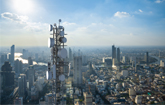Breaking Down 5 Misconceptions to Accelerate Green Development
BARCELONA, Spain, Feb. 27, 2022 /PRNewswire/ -- Huawei hosted its Day0 Forum "Lighting up the Future" as part of their lead up to MWC22 Barcelona. Huawei Carrier's Chief Marketing Officer Dr. Philip Song delivered a keynote speech titled "Five Misconceptions of Green Development" at the forum. He said, "Green development is a buzzword. Just like from Newton's classical mechanics to Einstein's theory of relativity, its development is going to be marked by a spiraling path between misconceptions and truths. We need to move past these five misconceptions as soon as possible to accelerate the green development of the ICT industry."
Misconception 1: ICT industry contributes to increased carbon emission. According to the GeSI's SMARTer2030 report, the ICT industry is only expected to account for 1.97% of global carbon emissions by 2030. More importantly though, other industries are expected to reduce their own carbon emissions 20% by applying ICT technologies, a total amount 10 times the carbon emissions of the ICT industry itself. These secondary savings are called carbon handprint. The size of this carbon handprint has made ICT infrastructure increasingly important in many national strategies. Huawei itself predicts that 1 YB of global data will be stored on the cloud by 2030. This means that 150 million tons of carbon emissions can be saved each year if current infrastructure is equipped with greener, all-optical transmission technologies. These savings would be equivalent to planting 200 million trees – an amount that would cover the entirety of Europe in forest.
Misconception 2: There is over-focusing on supply chain emissions, which are regarded as the largest cause of carbon emissions for network equipment. As Dr. Song described in his presentation, if you look at the entire life cycle of network equipment, only 2% of its carbon emissions are generated during manufacturing, while 80-95% are generated during usage. Dr. Song therefore proposed that the key to reducing ICT industry carbon emissions will be adopting innovative technologies to improve energy efficiency.
Misconception 3: Green development is only about green energy. While the development of solar and wind power are important to green development in the ICT industry, huge gains can be achieved by systematically improving the energy efficiency of telecom networks. To this end, Huawei released a three-layer green solution at this summit to systematically improve network energy efficiency through "Green Site, Green Network, and Green Operation", helping carriers achieve "More Bits, Less Watts".
Misconception 4: Network energy efficiency is equal to the sum of energy efficiencies of its telecom equipment. The energy efficiency evaluation of a single equipment box is not enough to carry out comprehensive, scenario-based planning and construction decisions. Huawei recommended establishing a unified, standardized indicator system (NCI) to accurately evaluate and formulate energy-saving policies for entire networks by measuring the energy efficiency indicators of main communications equipment, site auxiliary equipment, transport networks, and data centers.
Misconception 5: Energy saving should not impact any network performance indicator. The truth is, there is trade-off between energy saving features and some network indicators. However, energy saving features can be adopted at the expense of peak rates and some other indicators, but without impacting actual user experience. In Germany, an intelligent shutdown solution has been deployed in shopping malls at midnight. Although it slightly reduces peak rates, it reduces site energy consumption by 10% without affecting user experience.
During his closing remarks, Dr. Song delivered five suggestions for green development in the ICT industry: "First, we should vigorously develop the ICT industry to enable green development in other industries. Second, we must pay more attention to carbon emissions of ICT infrastructure during usage rather than just during manufacturing. Third, the systematic solution of "Green Site, Green Network, and Green Operation" will help carriers continuously improve network capacity and reduce power consumption per bit, achieving "More Bits, Less Watts". Fourth, we must define a unified energy efficiency indicator system to identify the main problems of energy consumption. Fifth, watts are decided by user experience."
MWC22 Barcelona will run from February 28 to March 3 in Barcelona, Spain. Huawei will showcase its products and solutions at stand 1H50 in Fira Gran Via Hall 1. Together with global operators, industry professionals, and opinion leaders, we will dive into topics such as industry trends, GUIDE to the Future, and green development to envision the future of digital networks. For more information, please visit: https://carrier.huawei.com/en/events/mwc2022.
SOURCE Huawei

WANT YOUR COMPANY'S NEWS FEATURED ON PRNEWSWIRE.COM?
Newsrooms &
Influencers
Digital Media
Outlets
Journalists
Opted In





Share this article